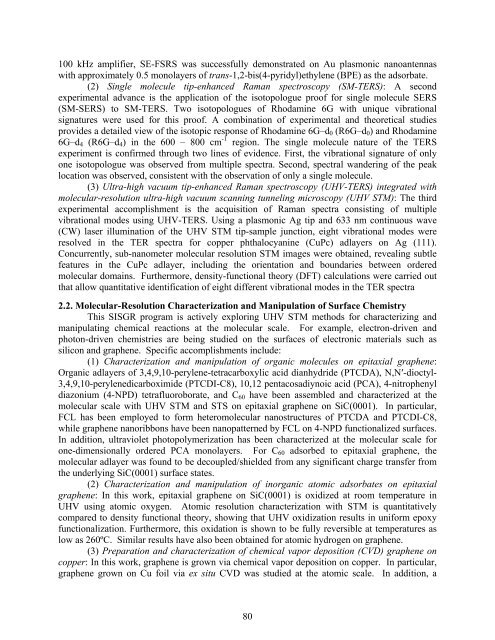Eighth Condensed Phase and Interfacial Molecular Science (CPIMS)
Eighth Condensed Phase and Interfacial Molecular Science (CPIMS)
Eighth Condensed Phase and Interfacial Molecular Science (CPIMS)
Create successful ePaper yourself
Turn your PDF publications into a flip-book with our unique Google optimized e-Paper software.
100 kHz amplifier, SE-FSRS was successfully demonstrated on Au plasmonic nanoantennas<br />
with approximately 0.5 monolayers of trans-1,2-bis(4-pyridyl)ethylene (BPE) as the adsorbate.<br />
(2) Single molecule tip-enhanced Raman spectroscopy (SM-TERS): A second<br />
experimental advance is the application of the isotopologue proof for single molecule SERS<br />
(SM-SERS) to SM-TERS. Two isotopologues of Rhodamine 6G with unique vibrational<br />
signatures were used for this proof. A combination of experimental <strong>and</strong> theoretical studies<br />
provides a detailed view of the isotopic response of Rhodamine 6G–d0 (R6G–d0) <strong>and</strong> Rhodamine<br />
6G–d4 (R6G–d4) in the 600 – 800 cm -1 region. The single molecule nature of the TERS<br />
experiment is confirmed through two lines of evidence. First, the vibrational signature of only<br />
one isotopologue was observed from multiple spectra. Second, spectral w<strong>and</strong>ering of the peak<br />
location was observed, consistent with the observation of only a single molecule.<br />
(3) Ultra-high vacuum tip-enhanced Raman spectroscopy (UHV-TERS) integrated with<br />
molecular-resolution ultra-high vacuum scanning tunneling microscopy (UHV STM): The third<br />
experimental accomplishment is the acquisition of Raman spectra consisting of multiple<br />
vibrational modes using UHV-TERS. Using a plasmonic Ag tip <strong>and</strong> 633 nm continuous wave<br />
(CW) laser illumination of the UHV STM tip-sample junction, eight vibrational modes were<br />
resolved in the TER spectra for copper phthalocyanine (CuPc) adlayers on Ag (111).<br />
Concurrently, sub-nanometer molecular resolution STM images were obtained, revealing subtle<br />
features in the CuPc adlayer, including the orientation <strong>and</strong> boundaries between ordered<br />
molecular domains. Furthermore, density-functional theory (DFT) calculations were carried out<br />
that allow quantitative identification of eight different vibrational modes in the TER spectra<br />
2.2. <strong>Molecular</strong>-Resolution Characterization <strong>and</strong> Manipulation of Surface Chemistry<br />
This SISGR program is actively exploring UHV STM methods for characterizing <strong>and</strong><br />
manipulating chemical reactions at the molecular scale. For example, electron-driven <strong>and</strong><br />
photon-driven chemistries are being studied on the surfaces of electronic materials such as<br />
silicon <strong>and</strong> graphene. Specific accomplishments include:<br />
(1) Characterization <strong>and</strong> manipulation of organic molecules on epitaxial graphene:<br />
Organic adlayers of 3,4,9,10-perylene-tetracarboxylic acid dianhydride (PTCDA), N,N′-dioctyl-<br />
3,4,9,10-perylenedicarboximide (PTCDI-C8), 10,12 pentacosadiynoic acid (PCA), 4-nitrophenyl<br />
diazonium (4-NPD) tetrafluoroborate, <strong>and</strong> C60 have been assembled <strong>and</strong> characterized at the<br />
molecular scale with UHV STM <strong>and</strong> STS on epitaxial graphene on SiC(0001). In particular,<br />
FCL has been employed to form heteromolecular nanostructures of PTCDA <strong>and</strong> PTCDI-C8,<br />
while graphene nanoribbons have been nanopatterned by FCL on 4-NPD functionalized surfaces.<br />
In addition, ultraviolet photopolymerization has been characterized at the molecular scale for<br />
one-dimensionally ordered PCA monolayers. For C60 adsorbed to epitaxial graphene, the<br />
molecular adlayer was found to be decoupled/shielded from any significant charge transfer from<br />
the underlying SiC(0001) surface states.<br />
(2) Characterization <strong>and</strong> manipulation of inorganic atomic adsorbates on epitaxial<br />
graphene: In this work, epitaxial graphene on SiC(0001) is oxidized at room temperature in<br />
UHV using atomic oxygen. Atomic resolution characterization with STM is quantitatively<br />
compared to density functional theory, showing that UHV oxidization results in uniform epoxy<br />
functionalization. Furthermore, this oxidation is shown to be fully reversible at temperatures as<br />
low as 260ºC. Similar results have also been obtained for atomic hydrogen on graphene.<br />
(3) Preparation <strong>and</strong> characterization of chemical vapor deposition (CVD) graphene on<br />
copper: In this work, graphene is grown via chemical vapor deposition on copper. In particular,<br />
graphene grown on Cu foil via ex situ CVD was studied at the atomic scale. In addition, a<br />
80
















